




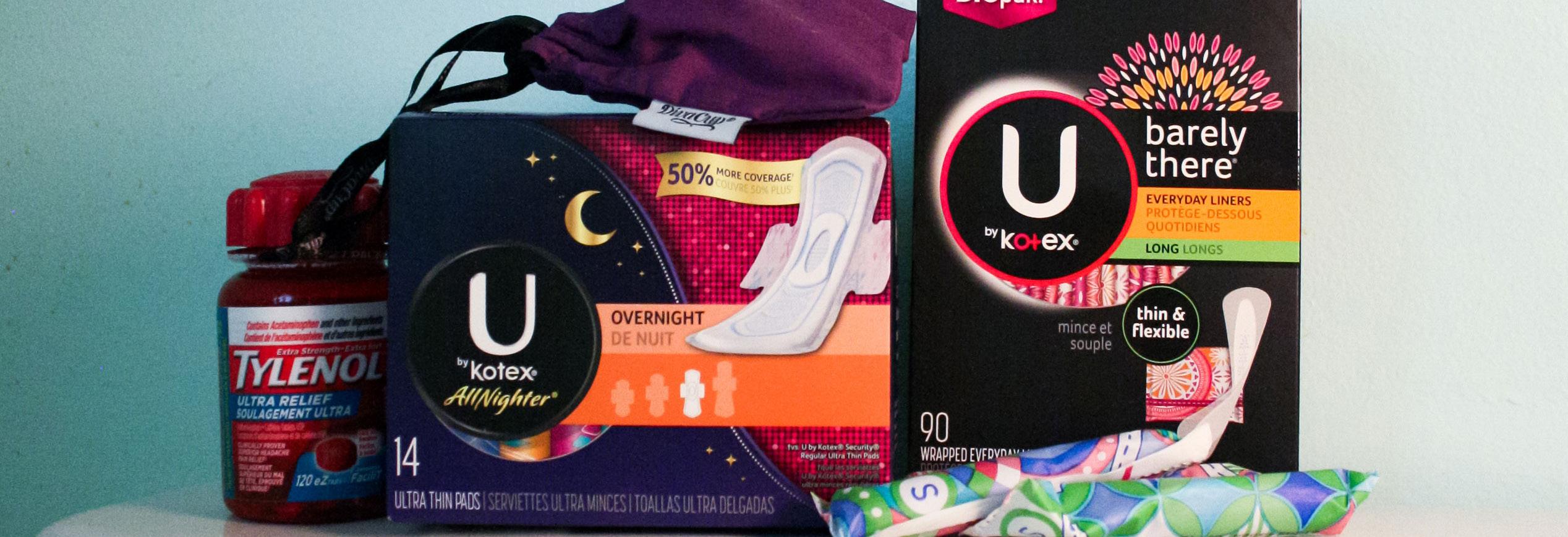


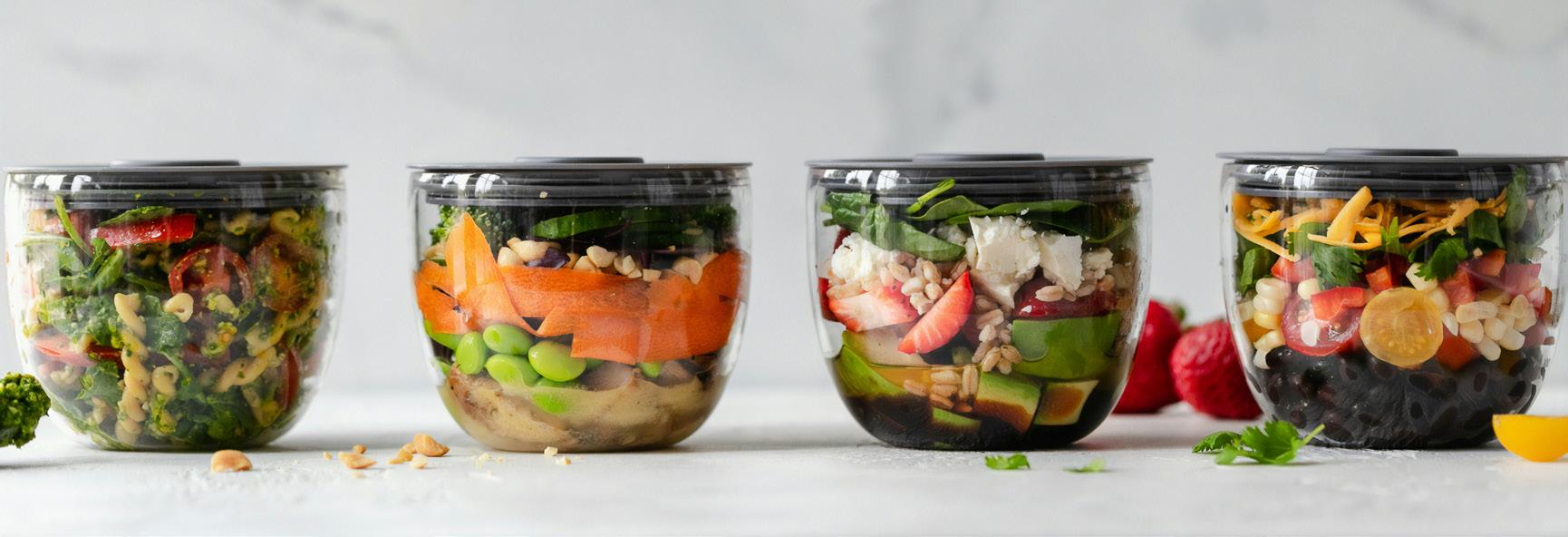
EDITOR-IN-CHIEF
Petra Chase eic@the-peak.ca
COPY EDITOR Michelle Young copy@the-peak.ca
FACT CHECKER
Karly Burns factchecker@the-peak.ca
NEWS EDITOR Olivia Sherman news@the-peak.ca
NEWS WRITERS
Hannah Fraser and Yashita Dhillon
OPINIONS EDITOR Olivia Visser opinions@the-peak.ca
FEATURES EDITOR Daniel Salcedo Rubio features@the-peak.ca
ARTS & CULTURE EDITOR Izzy Cheung arts@the-peak.ca
HUMOUR EDITOR C Icart humour@the-peak.ca
STAFF WRITERS
Kaja Antic, Yasmin Hassan, and Hailey Miller
BUSINESS MANAGER Yuri Zhou business@the-peak.ca (778) 782-3598



PROMOTIONS MANAGER
Juliana Manalo promotions@the-peak.ca
PRODUCTION & DESIGN EDITOR Abbey Perley production@the-peak.ca
ASSISTANT PRODUCTION EDITORS Minh Duc Ngo and Josh Ralla
PHOTO EDITOR
Gudrun Wai-Gunnarsson photos@the-peak.ca
WEB MANAGER
Subaig Bindra web@the-peak.ca
MULTIMEDIA EDITOR
Emma Ciprian
ASSISTANT MULTIMEDIA EDITOR
Quinn Masselink
BOARD OF DIRECTORS
Emma Jean, Payal Raj, Olivia Visser, and Yuri Zhou
CONTRIBUTORS
Puneet Aulakh, Zobia Khalid, Marie Jen Galilo, and Mahla Rae
PEAK ASSOCIATES
Prerita Garg, Amrit Kamaal, Aliya Nourlan, and Jin Song
COVER PHOTO Gudrun Wai-Gunnarsson
The Peak MBC2900 8888 University Dr. Burnaby, BC V5a 1S6 (778) 782-5110


Follow us on Instagram, at @thepeakatsfu and check out our YouTube channel, The Peak (SFU).
READ THE PEAK Find extended articles at the-peak.ca Download digital issues at issuu.com/peaksfu
The Peak is the official weekly student newspaper of SFU and is published every Monday. We’re funded by a student levy and governed by a Board of Directors. Any SFU student can apply to become a writer or editor.
We reserve the right to edit submissions for length, as well as style, grammar, and legality. We also reserve the right to reprint submissions at any time, both in print and on web. We will not publish content that is sexist, racist, or otherwise prejudiced.
We acknowledge that The Peak’s office is located and our paper is produced, distributed, and read on the Unceded Coast Salish Territories of the xwməθkwəy̓əm (Musqueam), səlilwətaɬ (TsleilWaututh), Kwikwitlem (Coquitlam), Kwantlen, Katzie, Semiahmoo, and Skwxwú7mesh (Squamish) Peoples. Unceded means that this land was never surrendered, relinquished, or handed over in any way. We recognize that the unceded land that we occupy includes not only the SFU Burnaby campus, but extends to the land occupied by the Vancouver and Surrey campuses as well.
In Volume 177 Issue 1 of The Peak, ”Fighting for Cleaning Workers,” we referenced the song “Cotton Eye Joe” in ”Relentless reasons to (not) love spring ” It has come to our attention that this song has racist connotations. We apologize for referencing a piece of work that has caused historical harm and negatively references enslaved people. We have removed the reference from our website.
Unhoused CRAB Park residents face destruction and confiscation of precious belongings
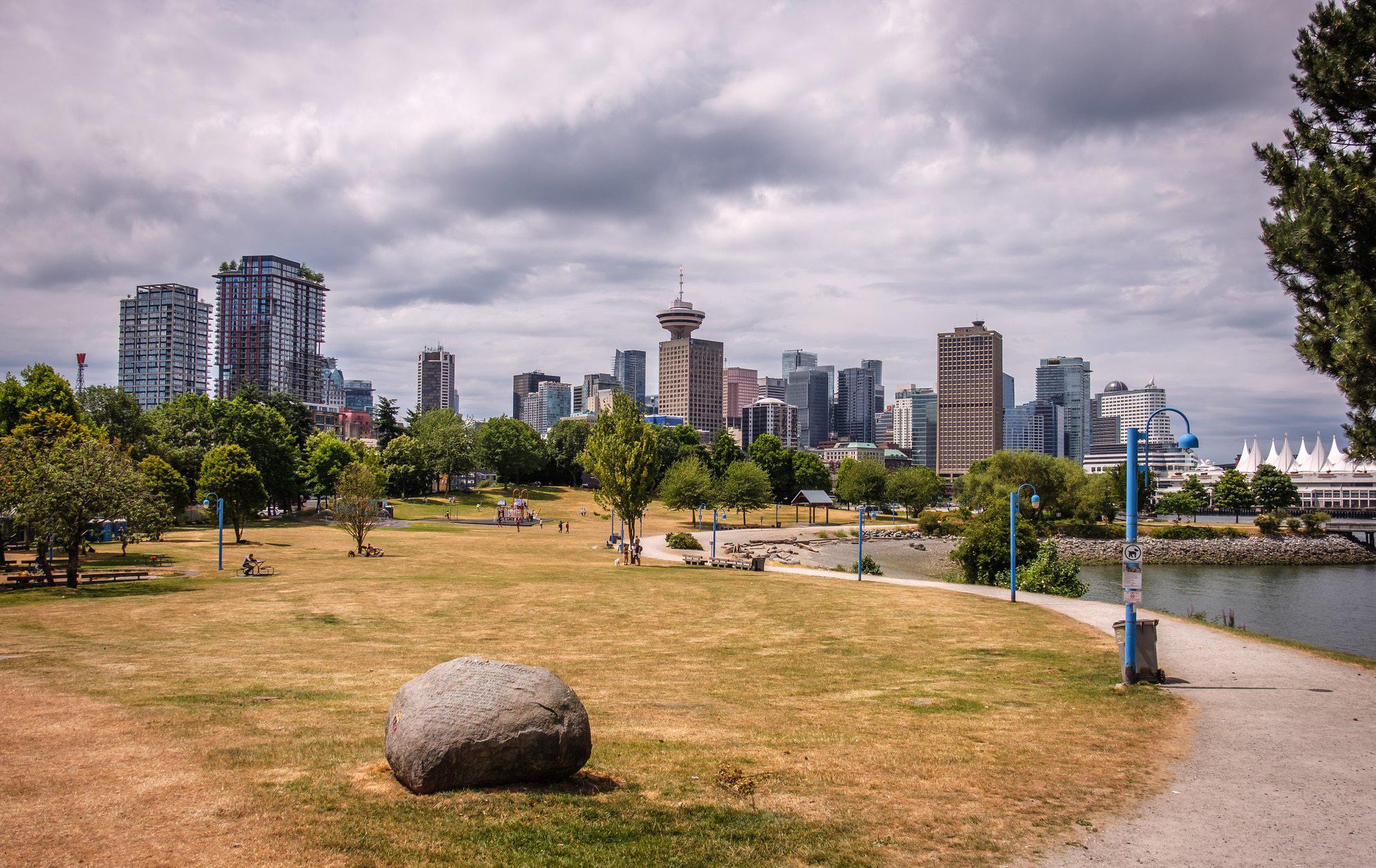
On April 16, the Vancouver Park Board began street sweeps of CRAB Park residents, forcibly removing any individuals outside the “14–tent ‘designated area’” on the peninsula. Park rangers dismantled residents’ homes and confiscated belongings according to bylaws, which say campers must pack up belongings by 7:00 a.m. The Peak corresponded with Fiona York, an advocate for CRAB Park residents, for more information.
In March, “over 30 residents were forcibly removed” from the park. About half are Indigenous, who are disproportionately impacted by the housing crisis and substance use. This is linked to various injustices committed over Canada’s history, such as colonialism, residential schools, and additional barriers to education and housing.
In March, residents were told they could move back after the “clean-up” of the park was completed, according to the press release by CRAB Park Tent City residents. Similar to the sweeps of the area in March, York claimed the Park Board intended to forcefully remove all the residents from the area.
On April 11, park rangers gave notice “to people on the south side informing them that the temporary sheltering area was [sic] ended, returning the park area to regular park use,” according to the City of Vancouver. The CRAB Park Tent City press release said the Park Board stated there would be an appeals process, though no additional information about it was provided to the residents before the sweep on April 16. York elaborated, “There obviously needs to be sufficient time for people to start the appeal process, present evidence, and be heard before there is any enforcement against them.”
“Supporters of CRAB Park residents are greatly concerned about this increase in enforcement, especially given that it was completed during cheque week,” read the press release. This is the distribution of monthly cheques for welfare and government assistance.
York explained that park rangers wait for residents to leave their homes to avoid confrontation. In 2022, the City of Vancouver apologized for the harm street sweeps were causing, but York noted “they still went ahead and did a mass, violent eviction of the tent city on Hastings Street on April 7, 2023.
“They did not follow through on the apology and nowadays they enforce street sweeps every single day on Hastings Street.”
York added that “the Park Board seems very interested in trying to look like they are being very compassionate, even when they’re not.” Specifically, she stated these street sweeps are violating “their dignity and right to shelter and safety,” especially with the increased anxiety that their home
and belongings could be seized at any time.
York noted how rare it is for items to be retrieved once confiscated. “It can take a lot of phone calls, emails, follow up, arranging transportation, and a lot of other hurdles that would be impossible to many homeless people that don’t have phones or emails or internet or electricity,” York said. She stated that even when a ranger returns a phone call, sometimes they have already marked the case as “closed.”
Rangers also took down the largest tent at CRAB Park which functioned as an “overdose prevention site, a peaceful gathering spot, a cultural site, and a memorial” for over three years. York said the tent’s destruction signifies a loss of community building, safety, and sense of belonging.
“It also signifies a huge gap in dialogue and consultation as residents were very clear [and] vocal about the significance and importance of the community tent, but the feedback wasn’t respected,” she continued. “The First Nations Leadership Council also referred to ‘the right to communal gathering’ in their open letter about the move,” said York.
York said the City of Vancouver and Park Board’s continued street sweeps shows the perpetuated stigmas and discrimination against unhoused individuals. Particularly, “believing that homeless people are somehow different from other people and don’t deserve to have access to their belongings, or because they somehow don’t deserve to be treated the same way as others,” she said.
Earlier this month, over 650 community members signed an open letter to encourage the city to stop the decampment operations. Supporters included Nicholas Blomley, a geography professor at SFU who co-authored the Belongings Matter report. Medical students at UBC wrote another open letter, which over 30 students signed.
York stated housing issues are “big systemic issues all over and should be treated with concern and real compassion instead of stigma and eviction.”
Residents of CRAB Park are going to the provincial Legislature in Victoria on May 8 to give MLAs the chance to directly hear their input and accordingly act on what they hear. They say most MLAs have not engaged with tent city residents, “nor have they engaged in meaningful dialogue with the community.”
Residents of CRAB Park are also proceeding to a hearing after opting to withdraw from mediation from a Human Rights Complaint.
The Peak reached out for comment from the Vancouver Park Board, but did not hear back by the publication deadline.
FoodMesh and Georgia Main Food Group work with 220 charities to feed British Columbians

Since 2020, BC organizations FoodMesh and Georgia Main Food Group have collaborated to build a network of 220 charities and farmers to distribute food to people living in food-insecure households. While food insecurity is at an all-time high, they have put 3.5 million meals onto the tables of British Columbians by donating unsold food from stores like IGA and Fresh St. Market. For more information, The Peak corresponded with Megan Czerpak, head of communications at FoodMesh.
Czerpak explained how “food is wasted for a variety of reasons, depending on where in the supply chain it is.”
For example, she said retailers may be unable to sell their stock if food is past its expiry date, has aesthetic imperfections, is overstocked, or has errors on the packaging. As a result, Czerpak noted that throwing out unsold food is “quicker, easier, and cheaper” for retailers. Georgia Main works to divert the most unsaleable food possible away from waste streams. According to Jessica Regan, CEO and co-founder of FoodMesh, “more than half of the food produced in Canada goes to waste,” showing “deep flaws in Canada’s food system.”
“Since our collaboration began in April 2020, IGA and Fresh St. Market have diverted over 2.1 million kilograms of food from ending up in waste streams,” Czerpak said.
Czerpak said FoodMesh coordinates the daily collection of unsold food to “ensure it is rescued and redistributed quickly and efficiently.” As FoodMesh measures the volume of food each store is diverting, “Georgia Main can track its progress against its food waste reduction goals.”
For example, the Immigrant Link Centre Society picks up and delivers fresh food from Fresh St. Market for newcomers to Canada who are otherwise unable to afford groceries. The CityReach Care Society also distributes food to underserved communities in Surrey, the Downtown Eastside, and 50 schools in the Greater Vancouver Area.
Further, Czerpak explained “the most recent Statistics Canada data showed that ‘nearly nine million Canadians live in food-insecure households’” which makes up approximately 23% of the population.
Czerpak said FoodMesh hopes “others see the example they are setting for the industry and follow suit.”
Experts and activists raise concerns regarding the recent provincial decision
YASHITA DHILLON · NEWS WRITER
In response to April’s removal of mandatory mask mandates in healthcare settings, BC’s health advocacy group DoNoHarm BC, joined by Protect Our Province BC and Masks4EastVan, are leading a campaign to urge the provincial government to reinstate these protections. The groups say that BC health authorities have ignored warnings about ongoing COVID-19 risks and other respiratory threats like measles and tuberculosis.
The decision to remove mandatory masks in healthcare settings was announced by the Ministry of Health, noting that “the peak of the respiratory illness season has passed.”
Though COVID-19 levels typically lessen in the spring, COVID-19 has not been established as a seasonal illness.
The Peak reached out to Dr. Karina Zeidler who organizes with DoNoHarm BC and is the co-founder of Protect Our Province BC for more information. Zeidler referenced a research article from BC Medical Journal which noted that “for some of these most vulnerable patients, the air in the hospital can be deadlier than the diagnosis that brought them in.” This is due to hospital acquired infections, which can then lead to COVID-19 deaths.
“There is no doubt that the absence of masks in healthcare mostly impacts those who are already pretty sick or those who can easily get sick like the elderly, immunocompromised people, or those with complex health needs,” Zeidler said. “A colleague of mine has had six of her long term care patients die of COVID-19 infections in the last six months that they caught in the hospital, and that is while we still had a hospital mask mandate.”
PERIOD PROMISE

“If there is one space that all vulnerable people should be able to rely on to prioritize their safety, it is in healthcare settings,” said the BC Human Rights Commissioner in a statement regarding the decision in 2023. The “removal of universal masking directives in healthcare settings does not uphold a human rights centered approach to public health.”
The narrative that public health has about COVID-19 has become completely divorced from what we actually know about the virus.
DR. KARINA ZEIDLER
PROTECT OUR PROVINCE BC
Despite over 18,000 British Columbians petitioning the government through the Vulnerability Isn’t Seasonal campaign to maintain and enhance healthcare protections, there has been little movement or acknowledgment from healthcare institutions or the provincial government, according to Zeidler.
“The narrative that public health has about COVID-19 which has become completely divorced from what we actually know about the virus,” said Zeidler. She explained the BC government continues to “push this narrative that COVID-19 has become nothing worse than a head cold that you might get in the winter,
The campaign aims to collect over 500,000 menstrual products in May
In an effort to combat period poverty across BC, United Way BC has launched its 2024 Period Promise campaign, which is an initiative that they’ve run since 2017 to fundraise, collect, and deliver menstrual product donations from Canadians and non-profits. They then deliver menstrual products to low-income Canadians. United Way BC has a broad focus, spanning from emergency responses and senior’s support, to youth activities and fighting food insecurity. In partnering with Pacific Blue Cross and CUPE Local 1816, they seek to address the growing challenges faced by those who menstruate through education on the societal impacts of period poverty, and calling for donations of products.
Period poverty refers to the barriers in accessing menstrual products, often due to financial constraints or societal stigma related to menstruation. Access to menstrual products has increasingly become a luxury for many.
The Peak spoke with Kim Winchell, provincial director of community impact and investment at United Way BC, who highlighted the growing difficulty of accessing menstrual products amid rising costs, particularly affecting students, workers, and single parents.
“Not having access to menstrual products isolates people,” Winchell explained. “So they miss community events, they miss social events, they miss school, they miss work, they miss medical appointments, and all of these can contribute negatively to health outcomes.”
Last year’s campaign saw over 800,000 menstrual products collected and distributed through 200 non-profit organizations.
“We’re really fortunate to live in a province where there is so much generosity from the general public,” she said.
“26% of people who menstruate have to make tough decisions about basic needs like paying rent or buying menstrual products,” Winchell explained, citing their Period Promise research project. This affects “health outcomes, employability, and participation in community events.”
To distribute menstrual products, United Way BC transports donations from collection points to non-profits and has partnered with DoorDash to facilitate free delivery of products across various locations. They also work with corporations and non-profits with large trucks, allowing for the transportation of menstrual products to remote areas.
Not having access to menstrual products isolates people. So they miss community events, they miss social events, they miss school, they miss work, they miss medical appointments, and all of these can contribute negatively to health outcomes.
same as the flu, and the more you are sick with it the less sick you’ll get. Except these two things can’t both be true.” She pointed out the contradiction in the diminishing of COVID19’s severity while it remains a leading cause of death and a significant source of long-term disability in Canada.
“It also poses a risk to our health care system in general. Every surge in COVID-19 cases leaves in its wake more burnt-out health care providers, more Long COVID in health care workers and an exodus of experienced senior nurses,” Zeidler noted. “We can’t afford to lose more staff — temporarily to acute illness, or long-term to Long COVID-19.”
Health advocates like Zeidler are calling for a shift in approach, advocating for airborne precautions as essential, not optional. This includes implementing filtration and ventilation in indoor spaces to reduce the amount of airborne pathogens breathed in the air.
“Just recently the WHO finally came out with a paper establishing that COVID-19 is a virus that spreads through the air. But it will be a while before things start to change in [healthcare settings] where we are still telling people to protect themselves from bad air by washing their hands and coughing into their elbow.
“There is very little, if any, reliable data on the consequences of the most recent removal of masks in healthcare settings in BC. But we know from last time BC experimented by dropping healthcare masking, it was followed by multiple COVID-19 outbreaks. Mask-wearing shouldn’t be optional, because there’s no acceptable amount of avoidable healthcareacquired infection.”
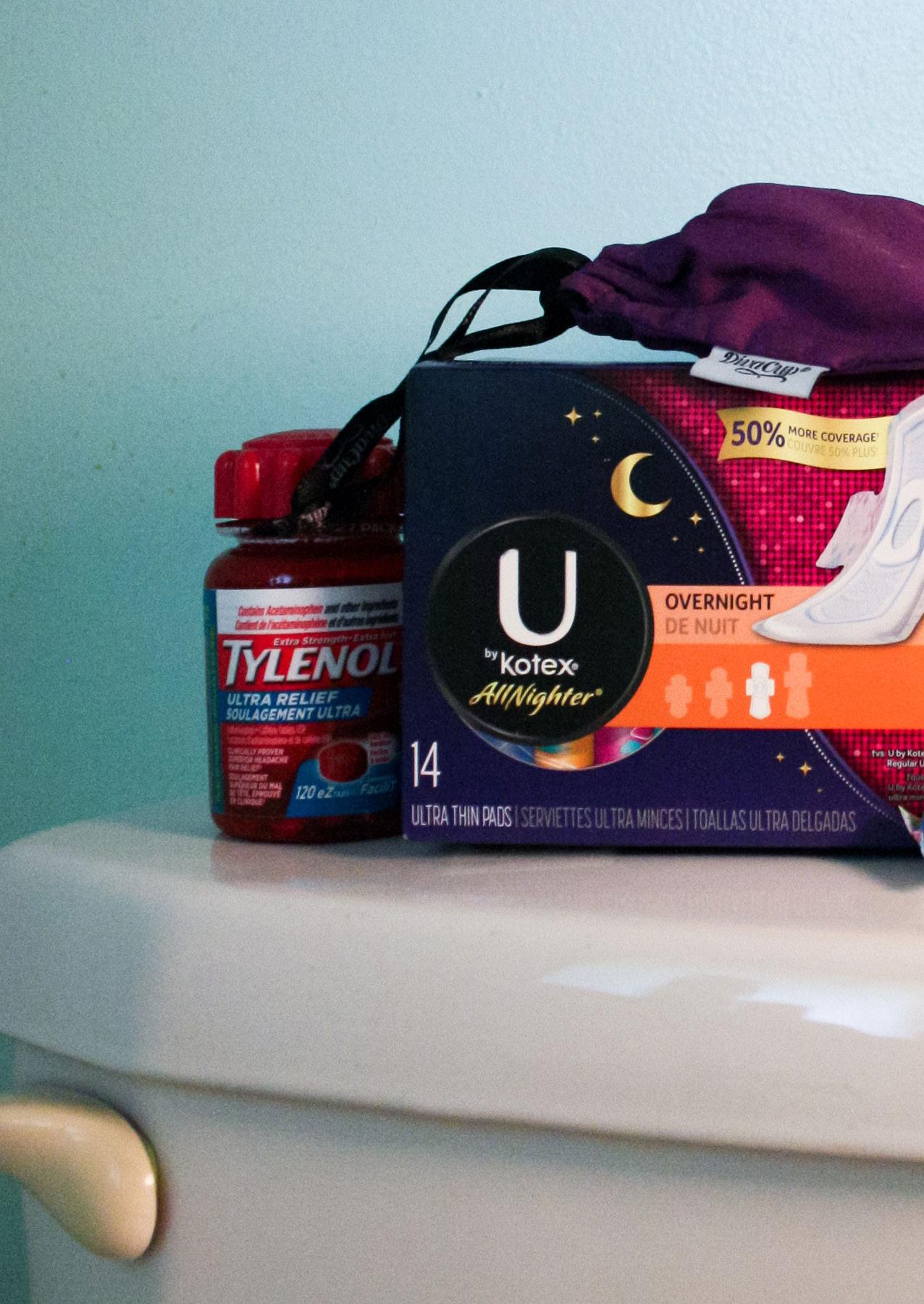
United Way BC aims to expand the accessibility of menstrual products to public spaces, not only to provide immediate access to necessary products but to normalize the availability of menstrual health supplies as a standard amenity. “We really hope to continue to raise awareness with people and communities about the need for this,” Winchell explained. “Oftentimes, we don’t talk about the essential need of period products.
“We want to remove stigma from the conversation. We also want to help workplaces, post-secondary institutions, and corporations to put free products into their bathrooms. And to make sure that is accessible for people that come into their workplaces as well.”
This is your sign to de-bulk your skincare routine

In my teenage years, the average skincare routine consisted of a cleanser, toner, and moisturizer. At this time, skincare was just beginning to bloom into the multi-billion dollar industry it is today. Sometimes it felt difficult to keep up with the most basic of routines back then. Yet these days, the variety of skincare products on the market feels overwhelming: retinoids, serums, vitamin formulas, you name it. And it’s not just the products themselves that are excessive; growing cultural trends and conversations tell us we need every formula under the sun for every possible skin concern, no matter how small. Why should we give predatory skincare companies $50 a month for items we aren’t even certain are effective? And moreover, why are we OK with being told that aging is unattractive or even avoidable?
Despite all those nighttime routine videos you may see while scrolling through your feed, dermatologists tend to agree that “less is more” when it comes to your skin. In fact, overuse of skincare products can cause irritation, breakouts, and dryness. So why the obsession with piling on eight different products twice a day? Don’t get me wrong, we all have different skin concerns and conditions. Some people need more intensive routines, and others don’t need much at all. But what we should be wary of are the extensive multi-step routines being sold universally to the average consumer, many of whom already have clear skin without the need for specialized products or treatments. The global skincare industry was worth $146.7 billion in 2021, and it’s only expected to grow. Most of these companies are aware of our insecurities and know they can profit off them. Have you ever wondered why many of them tend to hire models with picture-perfect skin? Do you really think none of their brand photos are filtered and edited?
The skincare industry isn’t just bad for our self-esteem, either. Despite the growing number of products made with recyclable packaging, 20–40% of beauty products “end up as waste.” A big part of this boils down to overconsumption. To avoid products you don’t need, it’s important to know your skin type and research the best products that’ll work for you. This prevents you from over-purchasing in hopes that one of many products will do the trick. If you’re not sure which products are helping and which are harming, it’s probably worth de-bulking your routine and starting fresh. According to dermatologist Dr. Whitney Bowe, the first place to start
when it comes to simplifying your routine is reducing “active” ingredients. This includes products like “retinoids, vitamin C, benzoyl peroxide, and lactic acid,” which can be harsh on your natural skin barrier. She recommends a “cleanser, moisturizer, and sunscreen,” which tends to be the consensus among skincare professionals. Another ingredient to avoid in skincare is fragrance. If you have specific skincare concerns, it’s worth seeing a dermatologist — but if that’s not possible, researching information from accredited dermatologists and peer-reviewed sources is the next best thing.
Remember that “signs of aging” are visible reminders that you’re alive.
There’s nothing wrong with having a specialized skincare regimen; for many people it’s a satisfying part of their selfcare routine. But at the end of the day, you can’t reverse aging and skin isn’t meant to be flawless. And unlike what these massive corporations want you to think, the most proven way to reduce major skin-related changes as you age is still just wearing sunscreen and avoiding excessive sun exposure. Don’t let yourself fall for heavily curated advertisements, paid promotions, or trendy products that use buzzwords like “fine lines,” “pore-shrinking,” or “dark circles.” Pores can’t disappear, dark circles are often genetic, and there is nothing wrong with aging. I gave up on my multi-step skin care routine years ago and I’ve never been happier — not to mention my wallet! And believe it or not, my skin looks exactly the same, if not better. Skincare is about taking care of your skin, not looking perfect. Yes, I still have visible under-eye veins and the beginnings of “crow’s feet” wrinkles, but those were never going anywhere with any amount of pricey products. Remember that “signs of aging” are visible reminders that you’re alive — and that’s nothing to be ashamed of.
Tim Hortons pizza is a danger to society

Sorry for the jump scare. But, $8 for half of a glorified frozen pizza is a problem. Tim Hortons’ slogan is “Always Fresh,” but we all know it’s Never Fresh. Their drinks are from concentrate and they reheat all their food. The coffee is literally flavoured milk, and we know calling it cold brew doesn’t change anything. And just when things couldn’t get worse — Timbits are a lost cause, too. And at the peak of all this chaos, there’s a new release: flatbread pizza.
Honestly, they should have just called it flatbread and stopped at that. It somehow looks worse than street pizza left overnight on the side of a public swimming pool. The pizza is dry, and the toppings aren’t properly placed. I have a lot of empathy for pizza makers since I play Good Pizza, Great Pizza. I can’t blame the workers for what this corporation forces them to do, but this is a whole new level. I had 14 customers lined up in that game and was still able to make better pizza than Tim Hortons on its best day. And honestly, that’s impressive for Tim Hortons. Pizza and coffee are probably the hardest things to mess up, but somehow Tim Hortons is able to do it.
Even the box looks low effort. In fact, Tim Hortons shapeshifts so much I forgot what it was originally for — coffee and donuts. I feel like one day we’re going to be looking for donuts and instead just find apples because Tim Hortons’ brand identity is now a grocery store.
I just cannot fathom that somebody would spend $8 to publicly humiliate themselves like that. It’s really concerning to see Tim Hortons trying to be something they’re not. So much self-hate I’m sensing here. And honestly, I’m so tired. Just bring back proper coffee, proper Timbits, and cheese melts.
A reflective review of the newest installment in a beloved Asian-inspired franchise
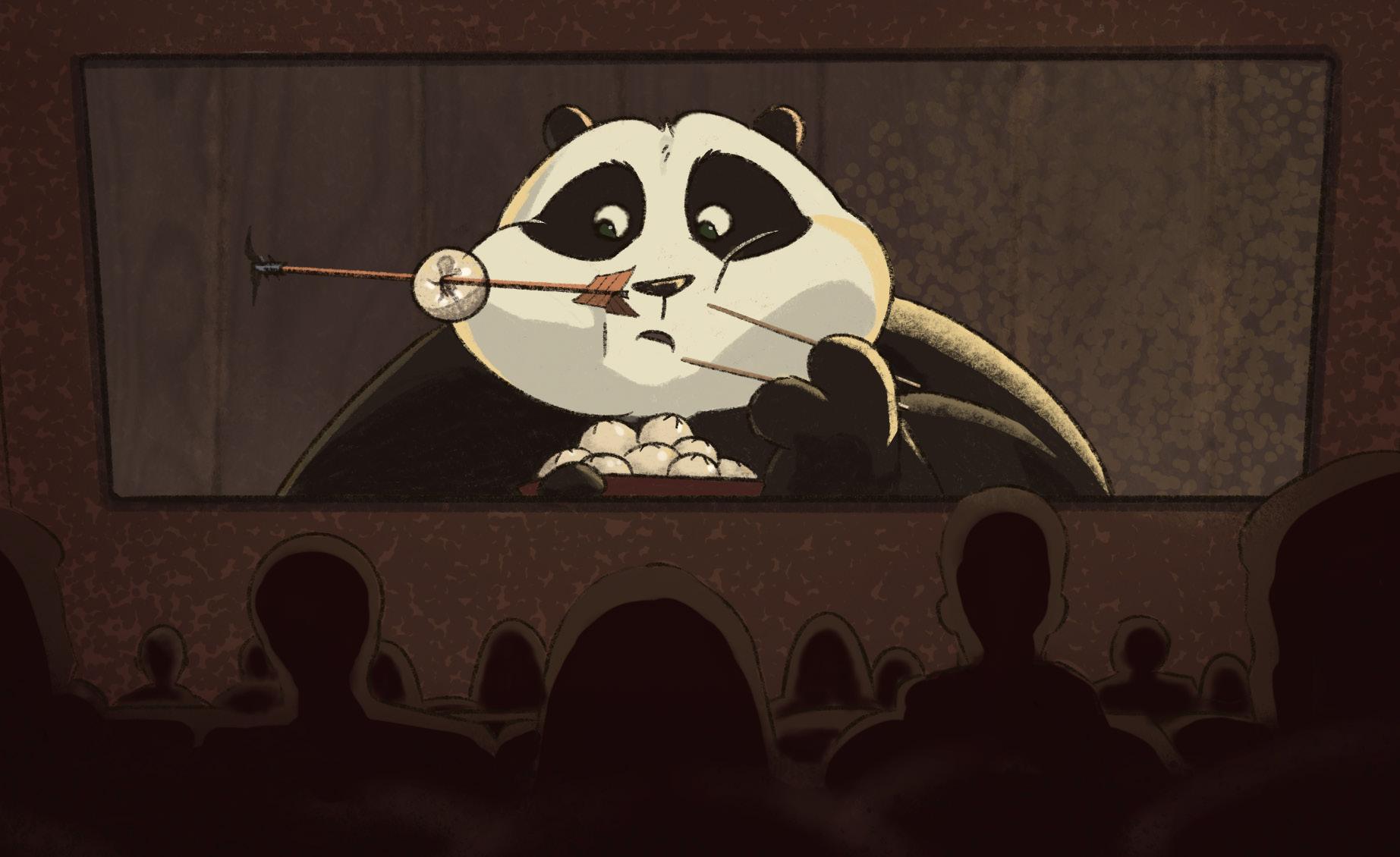
It’s hard to understate the impact of Kung Fu Panda (2008) on pre-teen me, along with many others. The scene revealing the truth behind the secret ingredient is something I still think about to this day. It tells us that the most successful, powerful thing you can be is yourself — truly yourself. This message of identity is universally important, but it was extra special to me coming from an intentionally Chinese-inspired movie. Representation matters . . . even when it’s from anthropomorphic animals. It’s Chinese North American in the best way possible and crafted with so much heart.
From the kung fu stances to the deliciously rendered food, this series is one of the best examples of positive East Asian representation I have seen to this day. We’ve come a long way from the likes of Breakfast at Tiffany’s and Full Metal Jacket. So many parts of Po’s characterization resonated with me, such as his love for dumplings and his nerdy excitement over martial arts. The thing that impacted me the most, however, is his search for identity and subsequent discovery that he truly is the overlap of everything that made him himself — and his relationship with his family. It calls to the intersection of filial piety so prevalent in many Asian cultures. Mixed with the desire to do things your own way — it’s an ode to the coming of age.
Kung Fu Panda shows us how our protagonist, Po, becomes the Dragon Warrior, a kung fu prodigy described in an inuniverse legend. Kung Fu Panda 2 (2011) has Po grow into his role and confront his past. In Kung Fu Panda 3 (2016), Po grows beyond his role by becoming a teacher and taking on more responsibilities. So when I heard the news of a fourth movie, I was perplexed. Po’s arc was complete. What else was there?
Despite this, I went into the theatre on May 2 with an open mind, and came out rather confused.
Let’s be clear: Kung Fu Panda 4 (2024) is not a bad movie. The animation is gorgeous, the shots are dynamic, the scenery is a love song to Ancient China, and Jack Black’s voice acting is flawless. Po’s adoptive goose father (Mr. Ping) and biological panda father (Li) are my favourite parts of the film, and I could not stop smiling every time they were on screen.
This message of identity is universally important, but it was extra special to me coming from an intentionally Chineseinspired movie. Representation matters . . . even when it’s anthropomorphic animals.
Yet, something is off. I don’t necessarily disagree with the central theme of the film — change and its necessity — but the way it’s executed feels clunky and breaks immersion. Shifu, Po’s kung fu teacher, tells him it’s time for him to pass the mantle on and stop being the Dragon Warrior so he can be a spiritual leader instead . . . which would make perfect sense if Po was old or not leading spiritually, both of which are false.
The audience has seen Po work so hard to become the Dragon Warrior, not only for himself but for those he wants
to protect. To see him need to give up this role for such an absurd reason feels like a backsliding of his character. Throughout Kung Fu Panda 4, Po is still the kindhearted, silly panda beloved by fans, but it seems like he’s confused about his place in the world. It’s a strange characterization decision on the part of the writers, considering Po has previously figured out his identity.
In Kung Fu Panda 3, there’s a scene where the main villain asks Po who he is. His response? “I've been asking myself that question. Am I the son of a panda? The son of a goose? A student? A teacher? I’m all of those things.”
Po’s character arc is complete. Early in the movie, Po himself all but acknowledges this. The unfolding plot doesn’t do much for his, the newly introduced Zhen’s, or anyone else’s character for that matter. There’s also the strange exclusion of the Furious Five, which was very awkwardly explained. Though the previous three movies were very much for kids, they still took themselves seriously, whereas this film had jokes crammed in left and right. The vibe was “quirky, silly TV episode” rather than a genuine installment to the otherwise heartfelt, thoughtful series. Altogether, I felt like this was, indeed, a cash grab, rather than a project born of passion. I don’t doubt that the individuals who worked on the film are passionate, but I’m sad to admit that I feel disillusioned by the corporation
In all, I’m honestly not sure who thought that we needed a fourth Kung Fu Panda to begin with. Po has grown as a character throughout the original trilogy of movies, and so have we the audience. The core of Kung Fu Panda is its emphasis on personal identity, and while this latest installment is still entertaining, it’s sad to see where it stands in context to the previous movies.
Tickets: free
Where: 515 Hastings St, Vancouver
When: May 15, 12:00 p.m.–1:00 p.m.
Ever since the first poetry reading in 2012, SFU has continued to hold Lunch Poems on a rolling basis. For the month of May, Lunch Poems at SFU features the literary works of Leanne Dunic, who is the fiction mentor for SFU’s The Writer’s Studio and leader of the band The Deep Cove. Works by the writer of Leaving Chang’e on Read, Jane Shi, will also be highlighted. This is not just for poetry connoisseurs — it’s open to anyone. So, whether you’ve always been passionate about poetry or have just developed an interest in it, this event is for you!

Tickets: $30 for adults (Ages 16+), $25 for kids (Ages 5-15)
Where: Town Centre Park, 1299 Pinetree Way, Coquitlam
When: May 18, 5:00 p.m.–8:00 p.m.
Colour Fest combines a celebration of past festivals Holi and Vaisakhi, hosted by the Diwali Celebration Society. Holi, which takes place in March, is the festival of colours, “the festival of love, and the festival of joy.” You can also celebrate Vaisakhi, “a harvest festival that originated in the Punjab region of Northern India.” In the colour zone, you can match the vibrancy of spring by covering yourself in powders made from flowers and herbs. Aside from music, dance performances, and the colour zone, there’ll also be food trucks and artisan markets.
Tickets: starts at $25
Where: Tonari Gumi, #101-42 W 8th Ave, Vancouver
When: May 26, 1:00 p.m.–3:00 p.m.
At the core of every culture is its cuisine, and the unique quality of each cuisine makes food an important part of cultural identity. One of the best ways to learn about other cultures is to learn about their food. The Japanese Canadian Heritage Cooking Classes collection is a program that allows Japanese Canadian home cooks to teach others about Japanese cuisine by sharing their family recipes. In Sen Sakamoto’s workshop, you can learn about Japanese cuisine by making and tasting a variety of wagashi.
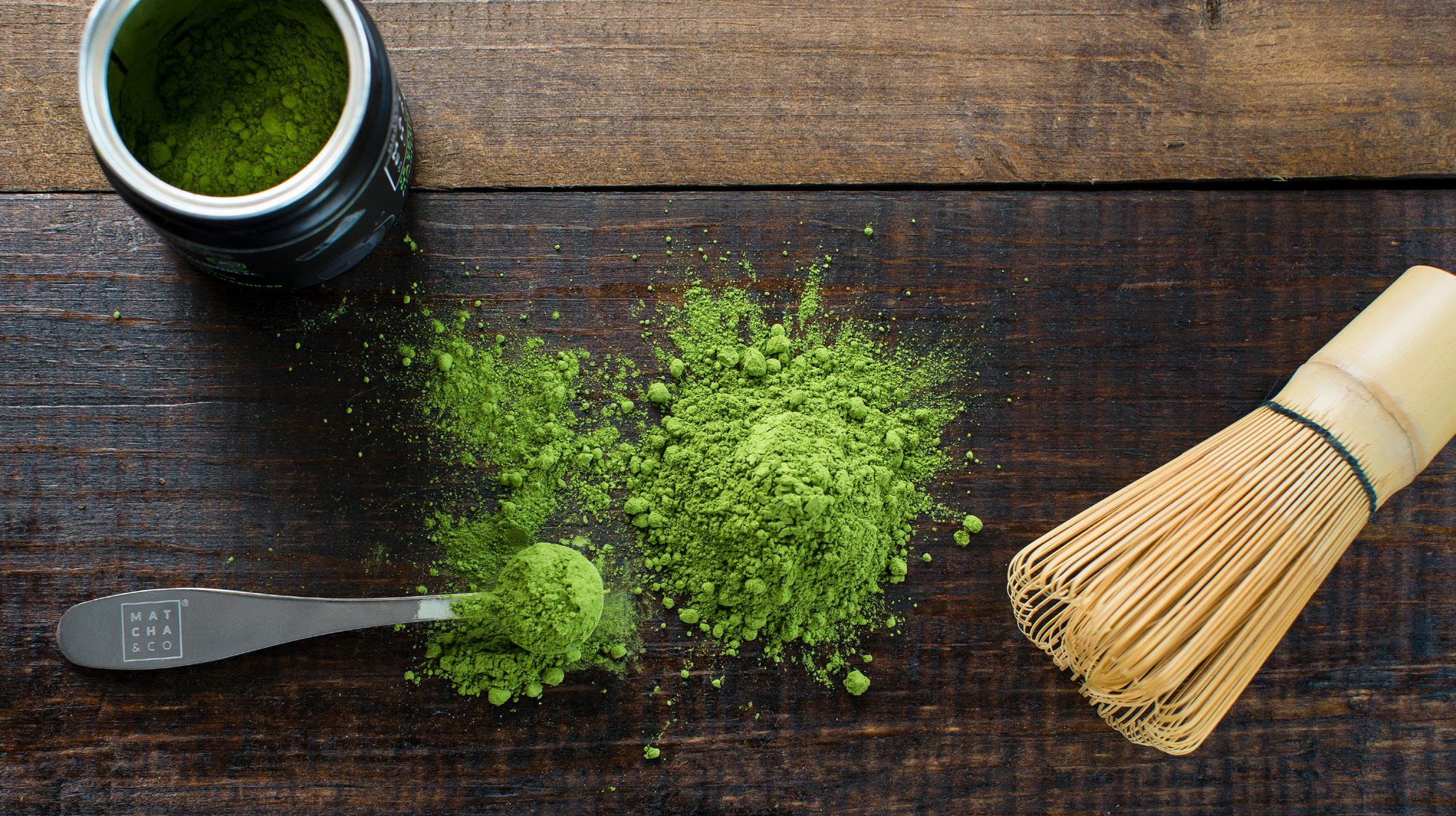
With summer weather right around the corner, many are turning away from cozy winter mochas and are looking for a new caffeinated option. Some tend to prefer classic iced coffees, while others may look to try the more colourful options on the menu.
An option that has become increasingly popular over the years is the iced matcha. Yes, these also come in hot varieties, but its vibrant green colour is usually only seen through the clear containers of cold drinks. This powdered tea offers around 70mg of caffeine per cup, making it a more moderate option compared to brewed coffee, which can yield between 100mg to 140mg per cup. With its earthy taste and thicker texture, this drink has been introduced in many North American cafés in recent decades, though its origin dates back centuries.
The plant that green teas come from — camellia sinensis — is thought to have been cultivated in China over 2700 years ago for medicinal and consumption purposes. Tea preparation methods evolved over the following centuries, with the origin of powdered green tea first coming up during the Tang Dynasty, which lasted from the 7th to 10th centuries. Steamed tea leaves
were compacted into bricks for ease during transportation. The tea itself was prepared by pulverizing the leaves within these tea bricks into a fine powder, which was then mixed with salt and water.
In the Song Dynasty, which lasted from the 10th to 13th centuries, the focus shifted to whisking this tea powder with hot water, similar to how matcha is often prepared today in cafés around the world. The term matcha stems from the combination of Japanese words “matsu,” which means to rub, and “cha,” which means tea. This tea mixture was introduced to Japan in the late 12th century by Zen Buddhist monk Myouan Eisai.
After returning to Japan from his Zen studies in 1191, Eisai also brought back green tea seeds with him, having learned the whisking methods that were used to create the caffeinated drink. Eisai noted the tea improved his Zen meditations, with the drink eventually becoming a staple in the Japanese tea ceremony — an art known as “chado.” Consuming matcha was seen as a way of attaining enlightenment, and ceremonies continue today with the purpose of intellectual exchange and care for continuing traditions.
The movement of these tea seeds would revolutionize the powdered drink, creating the difference between matcha and other powdered green teas. Matcha comes from tencha tea leaves that are grown in the shade, whereas other green powder teas come from the same tea leaves grown in the sun. The shading process adds the amino acid theanine which interacts with caffeine to create the sense of “calm alertness” that Eisai described.
Today, there are two common grades of matcha. Ceremonial is the more refined grade that is used to make traditional matcha tea when whisked with hot water, while culinary grade is more coarse and bitter, and is often used in baking as well as matcha lattes.
Iced or not, matcha lattes are my personal favourite, and I highly suggest trying it if you never have. Renaissance Cafe on SFU’s Burnaby campus is my usual go-to for matcha lattes (I particularly like them made with oat milk). Whether you are looking for a new iced caffeine source for the summer, or a calming energy boost for the winter, matcha is perfect for any season — and there are centuries of history to back up its popularity.

#130-3900 Bayview St, Richmond
Tues–Sun: 11:00 a.m.–2:30 p.m. and 5:00–8:00 p.m., Mon: closed
Kari House is a Malaysian restaurant overlooking the water on the Steveston boardwalk. Their dishes complement the gorgeous view, as they serve up a variety of soups, salads, rice, noodles, curries, and stir fry featuring seafood, meat, and vegetarian options.
Their pad thai, mixed vegetables with red curry or peanut sauce, and pineapple fried rice are all must-tries. With various sauces, vegetables, and protein to choose for each dish, there are countless tasteful options for everyone. I recommend sharing a little of this and that.
Their spicy dishes will surely spice up your life!

#102-1250 Dominion Ave, Port Coquitlam
Wed–Sun: 5:00–8:30 p.m.
Mon–Tues: closed
This family-run Japanese restaurant, owned by husband and wife duo Katsu and Kanako, is the perfect hidden gem for a delicious Japanese meal. Their sushi bar and kitchen feature every type of dish you can imagine, with hot and cold entrées — such as Ebi Chili Mayo or their Tempura Soba — that rotate the menu depending on the season.
Start off with a simple bowl of miso soup or a side of edamame. It’s a must to order some sushi here. Their kappa, natto, and the mixed vegetable and avocado rolls are a few of my favourites. They also offer various types of sashimi, nigiri, maki, and ura maki.
Shyun is hands-down the best Japanese restaurant in town. If you stop by, tell Katsu and Kanako I say, “Hi!”
#107-3003 St. John’s St, Port Moody
Mon–Tues: 11:00 a.m.–3:00 p.m. and 5:00–8:30 p.m
Thurs–Sun: 11:00 a.m.–8:30 p.m. Wed: closed
Kurumba is a Himalayan restaurant offering various dishes from curries and omelettes, to fried rice and chow mein. They feature a mix of Singaporean, Malaysian, Chinese, Indian, and Sri Lankan cuisines. Many of their dishes are on the spicy side, so if you can take the heat, this is the place for you!
My favourite dish is the mixed vegetable yellow curry. Pair it with some vegetable fried rice and chow mein or pad thai, and it’s the perfect meal to share with friends. They have countless seafood, meat, and vegetarian options for nearly everything on the menu, making it suitable for everyone.
2786 Barnet Hwy, Coquitlam
Tues–Fri: 11:30 a.m.–9:30 p.m.
Sat–Sun: 12:00–9:30 p.m. Mon: closed
Lazzez’s has a variety of options for curries, naans, rice, tandoori, and appetizers. Some of my favourite vegetarian dishes are their vegetable zalfrezi, vegetable briyani, and mutter paneer (with green peas, ginger, and spices).
You can’t go wrong with rice pulao and naan or roti. Their spinach paneer naan and onion kulchas are tasty additions to plain naan — I highly recommend them. They also have an Indo Chinese section featuring vegetarian, chicken, or beef manchurian and chilli paneer dry.
With affordable prices and a hefty menu selection, you’ll surely have a delectable meal here.
Got milk? Yeah, me neither


If you’ve recently gone grocery shopping, you’ve likely noticed concerning rises in food prices. Why has everything gone up a couple of bucks, but the portions have gotten smaller (also known as shrinkflation)? Why have the prices for staple items skyrocketed in the past few years with little consensus on why? Why are our wages so low, and our produce prices incredibly high? These are just some questions many people like me are asking. I’m no economist, I’ll admit that right now. But, that doesn’t mean these terms aren’t worth trying to understand, nor does this mean we shouldn't hold powerful parties accountable.
Many people are speculating why grocery giants have done little to change the costly nature of buying food. Back in March 2023, CEOs of the largest grocery store corporations (Loblaw, Metro, and Empire) met before Parliament to defend against accusations of profit-mongering, or, as the NDP might call it, “greedflation.” I’m not the only one who thinks these costs that affect food inflation aren’t entirely up to supplychain mishaps or the carbon tax. It’s a bit unrealistic for company CEOs to expect people to afford basic necessities like food, hygienic products, and other commodities when they’re economically unobtainable.
The NDP passed a bill to lower grocery prices and increase the extent to which the Competition Bureau has the power to prevent large corporations from abusing their dominant positions in the market. On top of that, organizations like the community union ACORN have also taken action in the form of protests and calling for increased taxes on corporate grocery profits, but some are saying that that’s not the answer to our problems. Another thing you might’ve seen is the recent Loblaw boycott — Loblaws is Out of Control — that started as a sub-Reddit, grew to 70,000 members and is now happening across Canada. The reasons driving these grocery prices up are like a trifle cake: too many layers. We can sit here and blame greed (a valid point) or the general rise of inflation, but the bottom line is that there are so many interchanging factors that have an unforeseen effect on consumers.
And how do our farmers feel about this? How have they been affected? Executive director of the BC Association of Farmers Markets, Heather O’Hara said farmers who sell at farmers markets are “not necessarily interested in volume and better margins” and that “the goal of a conventional mass grocer is different than the goal of a farmers market.” As much as
no one’s immune to food inflation, farmers are impacted in a similar way. Although many say it’s better to shop locally and support your farmers, which I totally agree with, sometimes it can be pricey! It’s all fair game, though, because oftentimes, the heightened cost of production is reflected in the cost of the product.
So, what can we do? Will fixed-price ceilings or prize freezes work? I doubt it. Prize freezes, according to some (and me), seem like a bit of a publicity stunt coming from the major grocery corporations in order to please the public for a while. Price controls won’t do anyone any good in the long run, because one way or another, the corporation’s expenses will be cut so they can continue to pocket outrageous profits — and that might mean actions like layoffs. Canada also relies heavily on imported food, especially during winter, so limiting exports won’t be beneficial either. But it’s not completely miserable. Some say that if we can increase food resilience — which means diversifying food sources to reduce the risk of shortages due to importation or weather and reduce domestic trade barriers — it might help bring costs down. Wage push inflation might also help in propelling the momentum for wages to catch up to high prices, but that will definitely take time.
Although it is getting better, wages are low and slow to catch up to the rate of inflation at this point. Even if we might be getting paid more, prices are still rising beyond pay increases, which makes the overall cost of living really uncomfortable. Raising wages is important but this doesn’t guarantee prices stop surging. If inflation is slowing down, and people get higher wages, that could lead to more spending which only makes inflation worse! Ultimately, wages need to keep up with inflation rates. Many of us will never be able to buy a home in the Lower Mainland at this rate, and that’s not to mention find an affordable apartment to rent — so why not at least make basic necessities something that’s accessible? Why should a family of four expect to spend an average of $16,297.20 on food this year? That’s not even accounting for people who have to choose between putting food on the table or paying rent for the month; how is it fair to them? This isn’t just about how food prices have risen — this all boils down to a reflection of the overall high cost of living in Canada right now. We should hold grocery giants responsible when price gouging, but that doesn’t mean it’s the only solution to this mess. What is clear is that the government needs to make affordability a top priority.
PHOTO: JIN SONG / THE PEAK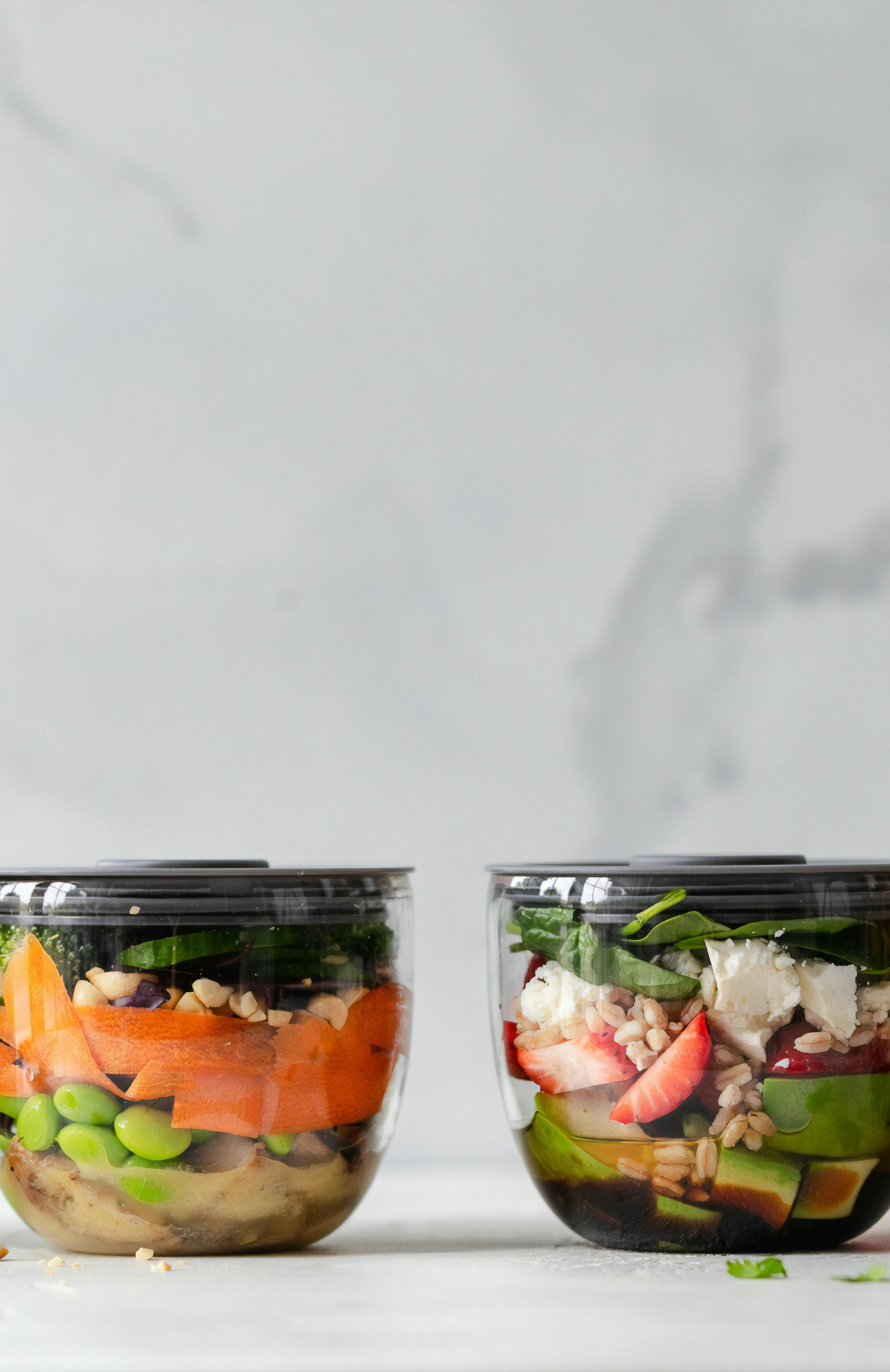
So, you want to prep your meals but don’t know where to start? We’ve got you. Cooking may seem like a daunting and annoying task, but meal prep can be great for saving money and time (things that are especially important for most college students). Convenience aside, it promotes conscious choices and builds valuable skills like cooking techniques, efficient grocery shopping, and staying in budget, things that go far beyond your life as a university student! Meal prepping can be so varied in flavours and ingredients, it doesn’t always have to be the bland stir-fried chicken and rice you usually see in meal prep videos; we’re here to show you how to mix and spice things up!
A IS FOR ASSESSING: PLAN AND PLAN SOME MORE!
Whether it’s on paper, a planner, or your phone, take time to carefully look through your weekly schedule. Seriously consider your courses, work, extracurriculars, and any other commitments — get everything on your calendar! Consider what you’ll want for breakfast, lunch, and dinner, making sure that you’re accounting for any medications or supplements you’re taking, your preferences, dietary restrictions, and nutritional goals (what you want your diet to reflect). Don’t forget snacks. When it’s in-between meals, and you’re craving something to soothe your hunger, cut-up fruits or vegetables, nuts (even trail mix), yogurt, or homemade energy bars are a great solution. Depending on how your schedule works, you’d be best off setting aside a certain day and time to prep, like every Sunday afternoon or evening.
B IS FOR BRAINSTORMING: RECIPES AND SHOPPING LIST
When looking for recipes that seem good for you, opt for recipes you can cook in bulk and require minimal ingredients. Things like rice, beans, and frozen pre-cut vegetables can go towards one-pot meals, casseroles, soups, and sheet pan recipes. Consider drawing inspiration from books like Jules Sherred’s Crip Up the Kitchen, which are tailored to people with disabilities for some accessible cooking tips.
Once you’ve got a steady list of recipes, go ahead and make a shopping list for the week. You might have some of the things you’ll need at home, so take inventory and check off anything you already have. Making a list will help you stick to getting only what you need, not just making impulse purchases (it’s OK. I’m guilty, too). Consider checking what’s in season at your local independent grocery shop or farmers market! Not only does sticking to seasonal ingredients will make your meals taste better, but your bank account will also thank you for it!
Tip:trackyourpurchasesandloghowmuchyouspendon groceriesperweek,doingthiswillgiveyouperspectiveonwhat ingredientscostmoreandmakefuturebudgetingaloteasier.
C IS FOR CREATING: PREPPING AND COOKING UP!
Dedicate time in your weekly schedule to prep ingredients and take into account the leftovers you might already have. This includes washing and chopping vegetables, cooking grains (such as a pot of rice), and marinating meats or tofu. There are a lot of cooking gadgets that can make chopping vegetables and time management easier. Cooking large batches of your proteins, grains, and greens will ensure that you have everything ready to divide into portions and leave leftovers. By doing this, you can also mix and match the components and ingredients of meals. For example, a portion of grilled chicken can go into a Caesar salad, a Mediterranean wrap, a rice bowl, or a stir-fry. Divide everything into sections and pack it away to store and divide into containers for meals!
Tip: consider preparing your ingredients (chopping, marinating, etc.) while sitting down or consider taking plenty breaks, sitting
down, or lie down entirely, if that’s easier for you. As it’s the case with any physical activity, listen to your body’s needs!
D IS FOR DIVIDING: ORGANIZING AND STORING YOUR FOOD
If you don’t already have containers, consider investing in good-quality containers to safely and properly store your meals (reusable bags, stackable containers). If you’re able to do so, and it helps you, consider labelling each container with the date and its contents to keep track of when each portion was packed — definitely my favourite task! It’s also a good idea to see how long the recommended time is to keep food stored in the fridge or freezer before you have to throw it out or re-purpose it, so check your “best before” dates and do your research, no food poisoning allowed! Make sure to follow safe cooking practices and that your meats are cooked all the way through.
Tip: keep your space organized. Try to tidy your fridge and pantry (ordormmini-fridge?)asyoucyclethroughyourmeals,itwill make cleaning up a far less demanding task.
E IS FOR EVERGREEN: FREEZER MEALS ARE OK!
Just because you made all this food and prepped all these meals doesn’t mean you have to eat all of it within the week. If you have leftovers, pack them away and keep them in the freezer to use when you don’t have time to make something fresh. This is especially helpful for when you know you’ll be having a busier week (finals season, for example) and won’t be able to dedicate as much time to meal prep as you normally do. Soups, broths, stews, and casseroles are all freezer-friendly as long as you remember when they’ve been made to keep track of how long they’ll last you.
Tip: for most instant pot recipes you don’t need to wait for your meals to thaw, just throw them into the pot and enjoy!
F IS FOR FUN: MAKE THE KITCHEN MORE ENJOYABLE
Put some music or a podcast on and vibe while you cook and pack! Don’t like doing it alone? Enlist your roommate, friends, or family members to help pass the time. Listen, life happens, so be flexible with your meal plan and adjust as needed. Don’t neglect your leftovers, instead, turn them into a new meal! For example, if you have leftover veggies like broccoli, potatoes, carrots, and onions, you can throw it all in a pot with veggie stock and there you have a simple veggie stew! If you have leftover rice, turn that into some quick fried rice; if you have leftover croissants or stale bread, turn it into savoury breakfast bread pudding! But, whenever cooking feels like more of a chore than a fun activity, consider going for the easiest meals to prepare from your recipe list.
Now that you’ve learned your ABCs, meal prep doesn’t seem like such a daunting task, does it? The more you practice and integrate it into your schedule, the more it becomes second nature. These skills are handy to learn now but will help you even more in the long run. What are you waiting for? Get to prepping, and don’t forget the snacks!


With the Paris 2024 Olympics quickly approaching, many of us at home lament that we can’t participate in the rigorous athletic competitions that trained athletes much younger than us are gaining medals for. Or, that’s what we may think.
As SFU students, we are eligible to compete in our own Olympic events — the difficulty of some being harder than those exhibited across the Atlantic in France this July. All you have to do is pick one or more of the following events to compete in! The International Olympic Committee doesn’t exist for these events; the only judges are the Burnaby Mountain raccoons.
THE AQ TO WEST MALL HALF-MARATHON
Don’t you love the trek across campus? Now it’s an official event! If you can make the crosscampus distance in under ten minutes, you earn yourself a medal! Navigating the packed walkways, climbing the concrete stairs, dealing with the cold mountain wind — this route can be a challenge for any student.
Still think it’s too easy? Try the UniverCity to Residence Marathon for an even harder challenge. Make sure to watch out for construction detours. They change every hour.
SWIMMING (MULTIPLE LOCATIONS)
With many fountains and ponds around campus, there are lots of options for swimming events, a

joy johnson breathes a sigh of relief because there is no sfu encampment
traditional staple at the regular Olympics. While we don’t recommend diving — seriously, save your spines, kids — short and long-distance swimming is available, even with the on-campus pool closed for renovations.
The short-distance competition will be held in Fountain Plaza, just west of Convocation Mall, while long-distance swimming will be held in the Jade Pond on the AQ 2000 level. Additionally, synchronized swimming will be held in the AQ koi pond. Don’t worry about assembling a team — the fish can coordinate a routine with you for this event!
The koi pond is an especially unique venue, as it can also play host to ice hockey during winter competitions (we at The Peak do not endorse this — though the Vancouver Canucks may be in talks with SFU to use it for training purposes)!
PIGEON DODGING
Author’s note: the previous iteration of this article included a similar event of Canadian Goose dodging. Due to concerns about human participant safety, this event has been cancelled to avoid further casualties.
Ever noticed the abundance of pigeons that make their way inside the campus, regardless of the time of year? Since these government spies love to see exactly what students are doing at all times, they are everywhere! This event is easy to enter — in fact, you’re probably already part of it! As long as
you have side-stepped, ducked, or ignored these dinosaur descendents, you have participated in this sport in some capacity! Congratulations, you’re an Olympian!
STANDING-ON-BUS-DURING-BURNABYMOUNTAIN-DESCENT
This event is only for the brave. The studentathlete that can stand on one of the various mountain-descending bus routes for the longest time without falling, wins the Olympic champion. Extra points will be awarded to those who can do this hardcore activity without holding onto any poles, handles, seats, or fellow transit-goers.
You may be asked to sign a waiver beforehand in case of twisted ankles. To be fair, you’d get the same injury walking along any outdoor space on campus, the risk in this bus is just gravity instead of potholes deeper than the Mariana Trench.
FINDING MCFOGG THE DOG
This is less of a sport and more of just a personal plea. Please find him so there is an ounce of character inside these blank concrete walls. Let this dog bring life back to a campus so deprived of it. Finding this lost dog nets you a gift card reward, so there is incentive. Please, SFU, we know there are budget cuts, but please return our beloved furry. The student Olympics need a mascot!

Content warning: mentions of genocide.
As she was sitting in her office reading the most recent message from the UBC president on the encampment on their campus, Johnson could not help but be grateful she did not have to make a similar statement. Some might say that silence is violence, but she likes to think that silence is aidance. See? It’s all about the mindset. While Benoit-Antoine Bacon’s
strategy of using percentages to camouflage a large number is commendable, Johnson was particularly impressed with how he was able to convey that funding genocide is just not something worth criticizing. Regardless of his claims, it’s a fantastic strategy to seem open to dialogue without actually having to plan a meeting.
Upon reflection, Johnson concludes that if she were to be put in the same situation (god forbid, student organizing gives her a headache, unless the students are organizing a photo-op), she’d likely ask AI writers to make the sentence, “Divesting from war contractors and complicit institutions goes against everything SFU stands for” more palatable for overly sensitive students. She wishes those little snowflakes who get their panties in a twist over escalating war crimes would understand that “this is still not the time.” Maybe it will be the right time once her tenure is over and the stars align in a particular way and pigs are flying around in futuristic cars like in The Jetsons . . . maybe. But certainly not before. Acknowledging that the university
is on unceded territories is already such a big and important step that should not be overshadowed by calls to do anything more. Land acknowledgements only happen a hundred years after colonization anyway.
In fact, any truly educated person would know that the university’s motto “Nous sommes prêt” (we are ready) is a shortened version. The full motto is actually “Nous sommes prêt à surveiller et réprimander toute action qui ne supporte pas l’image progressiste que nous voulons refléter” (We are ready to surveil and reprimand any action that does not support the progressive image we want to reflect). Well, to be fair, according to historians, this is contested because there are also mentions of alternate versions such as “Nous sommes prêt à appeler Lions Gate Risk Management sur vous” (We are ready to call Lions Gate Risk Management on you) and “Nous sommes prêt à quitter la salle lorsque les manifestants nous tombent trop sur les nerfs” (We are ready to leave the room when protestors are annoying us). Anyways, enough reflecting. Johnson must go find something to do to justify her obnoxiously large salary.
Dear Peakie,
I think it’s time for me to be brave and ask a question that I’ve been avoiding for years. 2024 is the year I don’t let anything hold me back. Asking questions is how we learn and grow as people. There is no reason to be afraid. I’ve read this column before, I know you do tend to be judgemental, but maybe you are also turning over a new leaf. So, here I go. Deep breath in, deep breath out . . . What in the world is a canuck!?
Sincerely, Don’t tell the hockey bros
Dear Scaredy,
Your bravery in admitting this is . . . interesting. Turning over a new leaf is important and can be very scary. Fortunately for me, I’ve never had to go through this and never will. Your comment on past perceptions of me as judgemental, while clearly wrong and coming from a place of jealousy, are noted. I would never claim to be perfect, because everyone I’ve ever met has directly (or indirectly) agreed that I am, so there is no need for me to say it. Based on the over explanatory tone of your message, I can tell you are from Canada. In this case, the fearful rambling before your question is understood, especially with your mention of the hockey bros. Clearly, you are aware that the Canucks are Vancouver’s hockey team, so it should be quite obvious that a canuck is an individual hockey player on the team.
Regards, Perfect Vancouverite
Dear Peakie,
There’s this guy in my class that I think is sooooooo cute. Like next level hottie. So obviously, my plan to catch his attention was to be as mysterious as possible. Did you know there’s a wikiHow page for that? When he and I got paired for a group project, I knew I had him. Given that wikiHow’s tip number five is to “avoid being available 24/7,” I just never responded to any of his messages about the project. Today was the day of our presentation and he was staring at me intensely the entire time. What else should I do to have him fall head over heels for me?
Mysteriously, Coquette Enigma
Dearest Coquette Enigma,
You have come to the right place, all of my Hinge practice has led to this. WikiHow is essential to starting any plan to catch a guy’s attention, but the next phase will seal the deal. Since you’ve already grabbed future pookie’s attention, now you need to work on making him come to you. While wikiHow recommends making eye contact for two seconds, you should actually stare directly at him until he makes eye contact regardless of how long it takes. Once eye contact is made, hold it until he gets intimidated enough to look away. Do this repeatedly as often as you can throughout class. By the end of class he will come up to you to talk. This next step is IMPORTANT! Before he speaks you need to cut him off immediately and ask what his problem is. Out of only 102 attempts, this has worked 30 times. Follow these steps and you will have a fellow forever in love with you.
Xoxo, Gossip Girl
Dear Peakie,
The ants are determined to make my home theirs . . . and honestly, who am I to stop them? Can I carry 50 times my bodyweight? Nope, I cannot! I tried to buy ant traps online from London Drugs, but with the store closures, who knows if they’ll ever get here. So, I’ve decided to pivot and make my home more welcoming to these earless guests. Obviously, I’ve been leaving food out for them. What else should I be doing?
Hospitably, Mi casa es tu casa
Dear new ant host,
This is a fantastic inquiry and I’ve got tons of suggestions! Some might call me a “good bug host” *wink wink*. One quick and easy trick is to find your favourite fabric, like your favourite sweater, and cut it into strips to lay out around the food you’ve left out so they can nap comfortably when they get sleepy after they eat. Next, a perfect investment is an essential oil diffuser. Put in relaxing or energising scents which are perfect for your lungless little friends. They will soak them up through the holes covering their body providing a constant full body aromatherapy. Put these tips into action as soon as you can and watch your new guests become roommates!
Best, Peakie
WRITTEN BY MAHLA RAE AND C ICART




